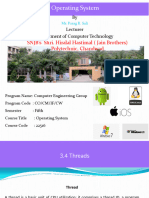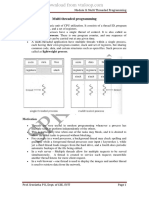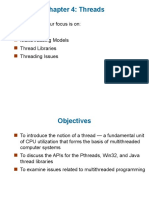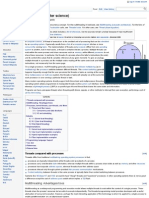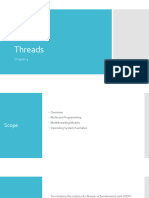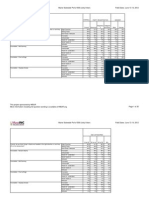Multithreading: An Operating System Analysis
Multithreading: An Operating System Analysis
Uploaded by
kielle18Copyright:
Available Formats
Multithreading: An Operating System Analysis
Multithreading: An Operating System Analysis
Uploaded by
kielle18Original Title
Copyright
Available Formats
Share this document
Did you find this document useful?
Is this content inappropriate?
Copyright:
Available Formats
Multithreading: An Operating System Analysis
Multithreading: An Operating System Analysis
Uploaded by
kielle18Copyright:
Available Formats
Multithreading
An Operating System Analysis
Author: Kevin Haghighat Date: December 1st 2008
Multithreading Kevin Haghighat December 1st 2008
1. OVERVIEW
Threads are an inherit part of software products as a fundamental unit of CPU utilization as a basic building block of multithreaded systems. The use of threads has evolved over the years from each program consisting of a single thread as the path of execution of it. The notion of multithreading is the expansion of the original application thread to multiple threads running in parallel handling multiple events and performing multiple tasks concurrently. Today's modern operating systems foster the ability of multiple threads controlled by a single process all within the same address space. Multithreading brings a higher level of responsiveness to the user as a thread can run while other threads are on hold awaiting instructions. As all threads are contained within a parent process, they share the resourses and memory allocated to the process working within the same address space making it less costly to generate multiple threads vs. Processes. These benefits increase even further when executed on a multiprocessor architechture as multiple threads can run in parallel across multiple processors as only one process may execute on one processor. Threads divide into two types: user-level threads visible to developers but unknown to the kernel, and kernel-level threads managed by the operating systems kernel. Three models identify the relationships between user-level and kernel-level threads: one-by-one, many-toone, and many-to-many. This report explores various notions related to systems with multithreading capability, including POSIX, Win32, and Java thread libraries. Challenges associated to multithreaded program development explored in this report are those of thread cancellation, singnal handling, thread-specific data, and symantics of necessary system calls.
Page 2 of 10
Multithreading Kevin Haghighat December 1st 2008
TABLE OF CONTENTS
1. 2. 3. 4. 5. 6. 7. 8. OVERVIEW ............................................................................................................................................... 2 INTRODUCTION........................................................................................................................................ 4 MODELS ................................................................................................................................................... 5 LIBRARIES ................................................................................................................................................ 6 CHALLENGES ............................................................................................................................................ 7 CONCLUSION ........................................................................................................................................... 9 ACKNOWLEDGEMENT: ............................................................................................................................. 9 BIBLIOGRAPHY ........................................................................................................................................10
Page 3 of 10
Multithreading Kevin Haghighat December 1st 2008
2. INTRODUCTION
Extensively simplified, a thread is the path that a process or application takes during its execution. Todays operating systems facilitate a multithread environment. This report will explore and discuss various concepts and issues associated with threads and multithreaded operating systems. It will discuss the root three models, followed by a few thread libraries, explore potential issues, application programming interfaces (APIs), followed by some examples of multithreaded operating systems and their thread support mechanism.
Motivation
Traditionally, programs are single-path execution, hence a single thread. This practice would have made the production of today's software production impossible as the need of speed required programs to perform multiple tasks and events at the same time. With traditional turn-by-turn game, such as tic-tac-toe or chess, the traditional approach works fine, however with new age multitasking programs where multiple events need to run in parallel, the traditional approach proves useless.
Benefits
Responsiveness: Multithreading allows a process to keep running even if some threads within the process are stalled, working on a lengthy task, or awaiting user interaction. Using a digital alarm clock as an example of a process, the thread of keeping track of time, continues while an alarm is sounding while another awaits it's time to activate. Cost Effective: Memory and resource allocation to process creation remains costly where as threads share the resources allocated to the process they reside in making it less costly to make threads or move them from on process to another. Resource Distribution: The inherit property of sharing memory and resources of the parent process fosters the ability of having multiple treads occupying the same address space. Cross-Processor Distribution: The benefits of multithreading are multiplied as the number of available processors increase opposite to single threading where only one processor is used. In a multiprocessor architecture, running of threads can distribute across multiple processors in parallel thereby increasing efficiency.
Page 4 of 10
Multithreading Kevin Haghighat December 1st 2008
3. MODELS
Threads divide into two types, user threads and kernel threads. User threads are user-level threads handled independent from and above the kernel and thereby managed without any kernel support. On the other hand, the operating system directly manages the kernel threads. Nevertheless, there must be a form of relationship between user-level and kernel-level threads. There exist three established multithreading models classifying these relationships as One-toOne, Many-to-One, and Many-to-Many. The one-to-one model (Figure 3.1) associates a single user-level thread to a single kernel-level thread. This type of relationship facilitates the running of multiple threads in parallel. However, this benefit comes with its own drawback such that generation of every new user thread must include the creation of a corresponding kernel thread causing an overhead, which can hinder the performance of the parent Figure 3.1: One-to-One Model process. Windows series and Linux operating systems try to tackle this problem by limiting the growth of the thread count. The many-to-one model (Figure 3.2) associates all userlevel threads to a single kernel-level thread. This type of relationship facilitates an effective context-switching environment, easily implementable even on simple kernels with no thread support. The down side is that since there is only one kernel-level thread scheduled at any given time, this model cannot take advantage of the hardware acceleration offered by multi-threaded processors or multi-processor systems.
Figure 3.2: Many-to-One Model
The many-to-many model (Figure 3.3) is a compromise between the last two models. In this model, a number of user-level threads are associated to an equal or smaller number of kernel-level threads. The requirement of changing code in both kernel and user spaces presents a level of complexity not present in the previous models. Similar to the many-to-one model, Figure 3.3: Many-to-Many Model this model presents an effective context-switching environment as it keep away from system calls. The heightened complexity presents the potential for priority inversion and suboptimal scheduling with little coordination between the user and kernel schedulers. Page 5 of 10
Multithreading Kevin Haghighat December 1st 2008
4. LIBRARIES
Thread libraries provide the means of thread generations and management as APIs in the development of multithreaded applications. The implimentation of such libraries are performed via two principal approaches: user and kernel levels. In the user level approach, all the actual code and data structures are held within the user space such that invoking a library method will result in a call to a local method within the user space rather than a system call. In the kernel level approach, the actual code and data structures are held within the kernel space such that invoking a library method results in a system call to the kernel since kernel level libraries are implemented by the operating system itself. The main thread libraries used today are POSIX Pthreads, Win32 threads and Java threads.
Pthreads POSIX Pthreads are commonly used in Linux systems. Programmers create and
manage Pthreads in both user and kernel levels.
Win32 Threads Implemented by Windows NT operating system and above, they foster
high-performance multhithreading. This type of thread belongs to the kernel level.
Java Threads In Java, thread creation and management is done within the program in 2
forms: 1) Extending a class where a child class inherits methods and variables from a single parent class as the most common form of creating Java threads. 2) Interfaces allow programmers to create an abstraction of future implementation of classes. This abstraction sets the stage while implemented interface classes perform the actual tasks while following the same sets of rules enforced by the interface.
Page 6 of 10
Multithreading Kevin Haghighat December 1st 2008
5. CHALLENGES
Just as with any new programming intervention, when using the multithreading consept, one must keep in mind the pottential chanllenges it presents. Some of such challenges are outlined in this section. System Calls One of the issues to keep in mind is how a system call deals with threads contained in a process that is getting duplicated. Do the threads also get duplicated or does the duplicated process only posses a single thread? Some Unix systems provide the means of both methods of duplication. Cancellations There are times when we may want to terminate a thread before it completes its purpose. This type of termination is referred to as thread cancellation. Imagine a chess game, where multiple moves are evaluated via different threads in order to find the shortest path of victory based on possible future moves. In such scenario, since all threads are running concurrently, as soon as one thread has found a path of victory, the rest of the threads can be cancelled since the found path would be the shortest path to a checkmate. When cancelling a target thread, we can take on of two approaches. One is asynchronous cancellation, where one thread terminates another that could lead to orphan resources since the target thread did not have a chance to free them. And the other, deferred cancellation, where each thread keeps checking if it should terminate and if so, do so in an orderly fashion freeing system resources used by the terminating thread. Signal Handling Unix systems use signals to keep track of events which must follow the same path of excecution as depicted in Figure 5.1, regardless of their type being synchronous or asynchronous.
An event occures. Create Signal is created. Deliver new signal to a Process.
Deliver
Signal recieved. Perform Handle Signal.
Figure 5.1: Path of an event execution.
Page 7 of 10
Multithreading Kevin Haghighat December 1st 2008
An illegal memory access or devide by 0 actions produce synchronous signals sent to the causing operations process. Asynchronous signals are those recieved as the result of an external event such as a keyboard commands like <ALT><F4> terminating a process, which are typically sent to another process. Thread Pools Eventhough creation of threads is more conservative than creating processes, unlimited threads can use up all the resources of a system. One way to keep this problem in check is the user of thread pools. The idea is to have a bunch of threads made upon the start of a process and hold them in a pool, where they await task assignment. Once a request is recieved, it is passed on to an available thread in the pool. Upon completion of the task, the thread then returns to the pool awaiting its next task. If the pool is empty, the system holds the requests until an available thread returned to the pool. This method limits the number of threads in a system to a managable size, most beneficial when the system does not posses enough resources to handle a high number of threads. In return, the performance of the system increases as thread creation is ofthen slower than reuse of an existing one. Thread-Specific Data The sharing of resources of the parent process does benefit multithreading programs, but in cases where a thread may need to hold its on copy of some data, called thread-specified data, it could be a downfall as well. The 3 main thread libraries discussed in this paper do provide support for such thread-specific handling which are often used as unique identifiers in transaction processing systems.
Page 8 of 10
Multithreading Kevin Haghighat December 1st 2008
6. CONCLUSION
With multithreading having become an integral aspect of computing today, developers can produce multithreaded programs offering a wide variety of features and functionalities in a high performance environment while not over utilising system resources. Developers need to pay close attention to the potential challenges associated to the use of threads as they could greatly hinder their development progress. I feel that Java threads merit special attention as Suns Java developments cross platform methodology has heightened its place amongst the top programming languages.
7. ACKNOWLEDGEMENT:
I would like to extend my thanks to Academic Institutes whom offered access to publications on this topic. My wife for her support and understanding throughout the masters program. I would also like to offer my thanks for all researchers without their research and publications this paper would not have been possible. We would also like to extend my appreciation to Dr. Mahmoud Abaza for his guidance in writing this paper.
Page 9 of 10
Multithreading Kevin Haghighat December 1st 2008
8. BIBLIOGRAPHY
Silberschatz, A., Galvin, P. B., & Gagne, G. (2004). OPERATING SYSTEMS CONCEPTS, (7TH EDITION READING ED .). Canada: John Wiley & Sons Canada, Ltd. Arora, N. S., Blumofe, R. D., & Plaxton, G. C. (1998). THREAD SCHEDULING FOR MULTIPROGRAMMED MULTIPROCESSORS . In SPAA '98: Proceedings of the tenth annual ACM symposium on Parallel algorithms and architectures, pages 119-129, New York, NY, USA. ACM Press. Drepper, U., & Molnar, I. (2003). THE NATIVE POSIX THREAD LIBRARY FOR LINUX. RedHat. Hilderink G.H., J.F. Broenink, & A.W.P. Bakkers. (1998). "A
NEW JAVA
THREAD
MODEL FOR
CONCURRENT PROGRAMMING OF REAL -TIME SYSTEMS ", Real-time magazine, 98-1, pages 30-34
Solomon D.A., & Russinovich M., (2000). INSIDE MICROSOFT WINDOWS 2000, Microsoft Press, Redmond, WA Lee, E. A. (2006). THE PROBLEM WITH THREADS. IEEE., Computer, 39(5):33-42. Thornley, J., Chandy, K. M., and Ishii, H. (1998). A SYSTEM FOR STRUCTURED HIGH-PERFORMANCE MULTITHREADED PROGRAMMING IN WINDOWS NT. In Proceedings of the 2nd Conference on USENIX Windows NT Symposium - Volume 2 (Seattle, Washington, August 03 - 04, 1998). USENIX Association, Berkeley, CA, 8-8.
Page 10 of 10
You might also like
- Managerial and Entrepreneurial ThinkingDocument2 pagesManagerial and Entrepreneurial ThinkingJaryzEricaRamosNo ratings yet
- Final PE9Document25 pagesFinal PE9Alfred Melvin Soliva0% (1)
- 5TH Operating System NotesDocument8 pages5TH Operating System NotesNeha ChinniNo ratings yet
- It Is The ThreadDocument17 pagesIt Is The Threadbhageshnarnawareg1No ratings yet
- Tutorial 4 Solution - OSDocument6 pagesTutorial 4 Solution - OSUnknown UnknownNo ratings yet
- Module4 Thread PDFDocument8 pagesModule4 Thread PDFElena MoralesNo ratings yet
- OS Notes For M.philDocument30 pagesOS Notes For M.philImtiaz AhmadNo ratings yet
- Multi Threaded Programming: Heavyweight Process. There Is One Program Counter, and One Sequence ofDocument39 pagesMulti Threaded Programming: Heavyweight Process. There Is One Program Counter, and One Sequence ofDhanyashree BNo ratings yet
- Performance Analysis of N-Computing Device Under Various Load ConditionsDocument7 pagesPerformance Analysis of N-Computing Device Under Various Load ConditionsInternational Organization of Scientific Research (IOSR)No ratings yet
- 4 ThreadsDocument17 pages4 ThreadsPrajwal KandelNo ratings yet
- OS Lecture4Document20 pagesOS Lecture4adiasaraf29No ratings yet
- Operating Systems: Suad AlaofiDocument13 pagesOperating Systems: Suad AlaofiAmal FahadNo ratings yet
- Threads in Operating SystemDocument8 pagesThreads in Operating SystemSujeethaNo ratings yet
- OS_Module2_Unit2Document43 pagesOS_Module2_Unit2padmakarnickNo ratings yet
- Assignment Os: Saqib Javed 11912Document8 pagesAssignment Os: Saqib Javed 11912Saqib JavedNo ratings yet
- ThreadsDocument9 pagesThreadsMd Majedul IslamNo ratings yet
- Parallelism. As Each Thread Receives Its Own Virtualized Processor and Is An Independently-SchedulableDocument1 pageParallelism. As Each Thread Receives Its Own Virtualized Processor and Is An Independently-SchedulablerijoiNo ratings yet
- Module IIDocument145 pagesModule IIUtkarsh GuptaNo ratings yet
- Web DevelopmentDocument7 pagesWeb DevelopmentVishal BhardwajNo ratings yet
- Threads and ProcessesDocument7 pagesThreads and ProcessesAlejandro ZapataNo ratings yet
- Thread (Computing) : A Process With Two Threads of Execution, Running On One ProcessorDocument9 pagesThread (Computing) : A Process With Two Threads of Execution, Running On One ProcessorGautam TyagiNo ratings yet
- Module 2 PptosDocument145 pagesModule 2 PptosvenugopalNo ratings yet
- OS MOD - 2 NotesDocument44 pagesOS MOD - 2 NotesSHALINI KGNo ratings yet
- Distributed Unit 2Document16 pagesDistributed Unit 2mj099159No ratings yet
- Chapter 1: Multi Threaded Programming: (Operating Systems-18Cs43)Document39 pagesChapter 1: Multi Threaded Programming: (Operating Systems-18Cs43)Vaishak kamathNo ratings yet
- ThreadDocument29 pagesThreadsumitbhadane22No ratings yet
- CH 4 (Threads)Document8 pagesCH 4 (Threads)Muhammad ImranNo ratings yet
- SlidesDocument36 pagesSlidesossamasamir.workoutNo ratings yet
- Operating System 6Document16 pagesOperating System 6Salim Rahaman Dipu 2111267642No ratings yet
- OS Assignments No.2 PDFDocument4 pagesOS Assignments No.2 PDFsheraz7288No ratings yet
- Module 2Document44 pagesModule 2shreya halaswamyNo ratings yet
- Chapter 3 ProcessesDocument19 pagesChapter 3 ProcessesMagneto Eric Apollyon ThornNo ratings yet
- ThreadsDocument24 pagesThreadsAjay Kumar RNo ratings yet
- Operating System - Multi-ThreadingDocument7 pagesOperating System - Multi-ThreadingHeo Công NghệNo ratings yet
- Threads in Operating SystemDocument2 pagesThreads in Operating SystemHuZaM KhanNo ratings yet
- ThreadsDocument23 pagesThreadszlatanNo ratings yet
- What Are ThreadsDocument6 pagesWhat Are ThreadsShobha KumarNo ratings yet
- Threads: 6.1 Overview 6.2 Multithreading Models 6.3 Operating System ExamplesDocument7 pagesThreads: 6.1 Overview 6.2 Multithreading Models 6.3 Operating System ExamplesCojanu CozminNo ratings yet
- Chapter 4: Threads: in This Chapter Our Focus Is On: Multithreading Models Thread Libraries Threading IssuesDocument23 pagesChapter 4: Threads: in This Chapter Our Focus Is On: Multithreading Models Thread Libraries Threading IssuesSanjeev RNo ratings yet
- ThreadsDocument10 pagesThreadsSharlin Lins LNo ratings yet
- Threads: by Salman Memon 2K12/IT/109 University of Sindh JamshoroDocument16 pagesThreads: by Salman Memon 2K12/IT/109 University of Sindh JamshoroP VsNo ratings yet
- Unit 4 - Cloud Programming ModelsDocument21 pagesUnit 4 - Cloud Programming ModelsMag CreationNo ratings yet
- Seminar Report On Threads in DsDocument23 pagesSeminar Report On Threads in DsAnjan SarmaNo ratings yet
- Server Operating System: Muhammad Umer Iqbal, 2162069Document5 pagesServer Operating System: Muhammad Umer Iqbal, 2162069Muhammad Hamza AzamNo ratings yet
- Chapter 4: Threads: in This Chapter Our Focus Is On: Multithreading Models Thread Libraries Threading IssuesDocument23 pagesChapter 4: Threads: in This Chapter Our Focus Is On: Multithreading Models Thread Libraries Threading IssuesSanjeev RNo ratings yet
- O.S - Theory Assignment 02Document7 pagesO.S - Theory Assignment 02Haadi KhanNo ratings yet
- 2 Assignment No 2 Chap 4 03042021 020349amDocument3 pages2 Assignment No 2 Chap 4 03042021 020349amatifNo ratings yet
- Os Lec 5 ThreadDocument10 pagesOs Lec 5 Threadfihava5658No ratings yet
- OS ThreadsDocument10 pagesOS ThreadsHimanshu NarayanNo ratings yet
- Multi ThreadingDocument5 pagesMulti ThreadingNitish GoyalNo ratings yet
- UNIT III (2)Document92 pagesUNIT III (2)yukthachowdarylavuNo ratings yet
- OS-module 2 NotesDocument35 pagesOS-module 2 Notesgj7cpz4fzyNo ratings yet
- Os - Module 2Document44 pagesOs - Module 2farha anjumNo ratings yet
- OS Multi-Threading ConceptsDocument25 pagesOS Multi-Threading Conceptsbtsarmyforeversince2020No ratings yet
- Threads and Its Types in Operating System - GeeksforGeeksDocument11 pagesThreads and Its Types in Operating System - GeeksforGeeksmyjobnexusNo ratings yet
- Unit - 3 - ThreadsDocument17 pagesUnit - 3 - ThreadsAyush ShresthaNo ratings yet
- Os Chapter 04Document14 pagesOs Chapter 04varnits30No ratings yet
- 4 OS ThreadsDocument25 pages4 OS ThreadsHanNo ratings yet
- ThreadsDocument16 pagesThreadscigila6437No ratings yet
- Operating Systems:: ThreadsDocument26 pagesOperating Systems:: ThreadsKadooj 8No ratings yet
- Distibuted Systems: Design and AlgorithmsFrom EverandDistibuted Systems: Design and AlgorithmsSerge HaddadNo ratings yet
- ASTM C 418 Standard Test Method For Abrasion Resistance of Concrete by SandblastingDocument3 pagesASTM C 418 Standard Test Method For Abrasion Resistance of Concrete by SandblastingILSEN N. DAETNo ratings yet
- SIM335 Managing Projects: Faculty of Business and LawDocument8 pagesSIM335 Managing Projects: Faculty of Business and LawtechnicalvijayNo ratings yet
- Consumer Protection Act Project (Ibrahim) 33333333Document16 pagesConsumer Protection Act Project (Ibrahim) 33333333Hamdulay Ismail50% (2)
- TERM/WEEKS: Term 1 (Weeks 2-3, Lessons 3-4-5) Year Level: 8 LEARNING AREA/TOPIC: Science - Cell BiologyDocument3 pagesTERM/WEEKS: Term 1 (Weeks 2-3, Lessons 3-4-5) Year Level: 8 LEARNING AREA/TOPIC: Science - Cell Biologyapi-408461912No ratings yet
- Shop Talk Issue 0002Document2 pagesShop Talk Issue 0002Chicago Transit Justice CoalitionNo ratings yet
- Kōan - WikipediaDocument17 pagesKōan - WikipediarippvannNo ratings yet
- Art of Arabic CalligraphyDocument5 pagesArt of Arabic CalligraphyAaea LisboaNo ratings yet
- WBUR Poll: Angus King Heavy Favorite To Replace Sen. Snowe (Crosstabs)Document35 pagesWBUR Poll: Angus King Heavy Favorite To Replace Sen. Snowe (Crosstabs)WBURNo ratings yet
- ExperimentsDocument50 pagesExperimentsOmed. HNo ratings yet
- Pecking Order TheoryDocument4 pagesPecking Order TheoryThunder CatNo ratings yet
- MeningoencephaloceleDocument13 pagesMeningoencephaloceleIda Bagus Yudha Prasista100% (1)
- GSIS APPLICATION Form 1Document1 pageGSIS APPLICATION Form 1Mikka KamilleNo ratings yet
- 6.the Powers of The MindDocument61 pages6.the Powers of The MindClarisse LealNo ratings yet
- Sr. ZoologyDocument11 pagesSr. ZoologykrishnaNo ratings yet
- Admit Card2023Document2 pagesAdmit Card2023Anikate SharmaNo ratings yet
- 6 Minute English Flexible WorkingDocument5 pages6 Minute English Flexible WorkingfebyNo ratings yet
- Axis & Allies Battle BulgeDocument7 pagesAxis & Allies Battle BulgeAllan RicardoNo ratings yet
- Discourse Analysis: Assist. Prof. Muhsin YanarDocument23 pagesDiscourse Analysis: Assist. Prof. Muhsin YanarDudu Nur DemirNo ratings yet
- De BuyerDocument248 pagesDe BuyerisaNo ratings yet
- AOAC967 - 30 - Ca y MGDocument1 pageAOAC967 - 30 - Ca y MGMaría De Los Ángeles SuárezNo ratings yet
- 6HR0ScR7U6HOLOXwLich Tuan 34 - v2.1Document3 pages6HR0ScR7U6HOLOXwLich Tuan 34 - v2.1vphuc1984No ratings yet
- Writing ReviewsDocument29 pagesWriting ReviewsLourence Albert Moreno MoleñoNo ratings yet
- Date Category Activity Cost For 2Document8 pagesDate Category Activity Cost For 2Haritsari DewiNo ratings yet
- Graphic Organizer CompletedDocument2 pagesGraphic Organizer Completedapi-518507034No ratings yet
- Chapter 28 Paternity and Filiation On NonDocument4 pagesChapter 28 Paternity and Filiation On NonWang BeauNo ratings yet
- Personalpower WorkbookDocument6 pagesPersonalpower WorkbookBratianu RazvanNo ratings yet
- Forms and Functions of Social Organizations Group ActivityDocument26 pagesForms and Functions of Social Organizations Group Activitymarissa casareno almueteNo ratings yet
- Initiation Instructions in Tantra YogaDocument19 pagesInitiation Instructions in Tantra Yogaanonyogi100% (1)




